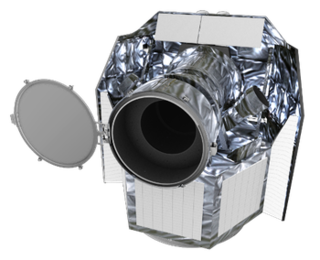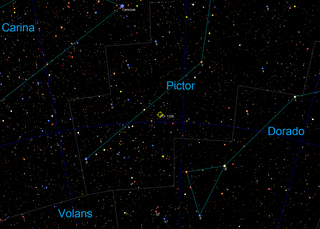Related Research Articles

An exoplanet or extrasolar planet is a planet outside the Solar System. The first possible evidence of an exoplanet was noted in 1917, but was not recognized as such. The first confirmation of detection occurred in 1992. This was followed by the confirmation of a different planet, originally detected in 1988. As of 1 March 2021, there are 4,687 confirmed exoplanets in 3,463 systems, with 770 systems having more than one planet.
Gliese 1061 is a red dwarf star located approximately 12 light-years from Earth in the southern constellation of Horologium. Even though it is a relatively nearby star it has an apparent visual magnitude of about 13 so it can only be seen with at least a moderately-sized telescope.

HD 219134 is a main-sequence star in the constellation of Cassiopeia. It is smaller and less luminous than our Sun, with a spectral class of K3V, which makes it an orange-hued star. HD 219134 is relatively close to our system, with an estimated distance of 21.25 light years. This star is close to the limit of apparent magnitude that can still be seen by the unaided eye. The limit is considered to be magnitude 6 for most observers. This star has a magnitude 9.4 optical companion at an angular separation of 106.6 arcseconds.

A super-Earth is an extrasolar planet with a mass higher than Earth's, but substantially below those of the Solar System's ice giants, Uranus and Neptune, which are 14.5 and 17 times Earth's, respectively. The term "super-Earth" refers only to the mass of the planet, and so does not imply anything about the surface conditions or habitability. The alternative term "gas dwarfs" may be more accurate for those at the higher end of the mass scale, although "mini-Neptunes" is a more common term.

An exoplanet is a planet located outside the Solar System. The first evidence of an exoplanet was noted as early as 1917, but was not recognized as such until 2016. No planet discovery has yet come from that evidence. However, the first scientific detection of an exoplanet began in 1988. Afterwards, the first confirmed detection came in 1992, with the discovery of several terrestrial-mass planets orbiting the pulsar PSR B1257+12. The first confirmation of an exoplanet orbiting a main-sequence star was made in 1995, when a giant planet was found in a four-day orbit around the nearby star 51 Pegasi. Some exoplanets have been imaged directly by telescopes, but the vast majority have been detected through indirect methods, such as the transit method and the radial-velocity method. As of 1 March 2021, there are 4,687 confirmed exoplanets in 3,463 systems, with 770 systems having more than one planet. This is a list of the most notable discoveries.

Planet Hunters is a citizen science project to find exoplanets using human eyes. It does this by having users analyze data from the NASA Kepler space telescope and the NASA Transiting Exoplanet Survey Satellite. It was launched by a team led by Debra Fischer at Yale University, as part of the Zooniverse project.

CHEOPS is a European space telescope to determine the size of known extrasolar planets, which will allow the estimation of their mass, density, composition and their formation. Launched on 18 December 2019, it is the first Small-class mission in ESA's Cosmic Vision science programme.
GJ 9827 is a star in the constellation of Pisces. It is a K-type main-sequence star with an apparent magnitude of 10.250. It is 97 light-years away, based on parallax.
WASP-47 is a star similar in size and brightness to the Sun about 870 light-years away in the constellation Aquarius. It lies within the Kepler K2 campaign field 3. It was first noticed to have a hot Jupiter exoplanet orbiting every 4 days in 2012 by the Wide Angle Search for Planets (WASP) team. While it was thought to be a typical hot Jupiter system, three more planets were found in 2015: an outer gas giant within the habitable zone, a hot Neptune exterior to the hot Jupiter's orbit and a super-Earth interior to the hot Jupiter's orbit. WASP-47 is the only planetary system known to have both planets near the hot Jupiter and another planet much further out.

Jessie Christiansen is an Australian astrophysicist working at the NASA Exoplanet Science Institute at the California Institute of Technology (Caltech). She won the 2018 NASA Exceptional Engineering Achievement Medal for her work on the Kepler planet sample.

K2-138, also designated EPIC 245950175 or EE-1, is a large early K-type main sequence star with a system of up to 6 planets discovered by citizen scientists. Four were found in the first two days of the Exoplanet Explorers project on Zooniverse in early April 2017, while up to two more were revealed in further analysis. The system is almost 600 light years away in the constellation Aquarius, within K2 Campaign 12.

DS Tucanae is a binary star system in the constellation of Tucana. It has an apparent visual magnitude of 8.5, and is a RS Canum Venaticorum variable. The system is notable for being young as a member of the 45 Myr old Tucana-Horologium moving group and for the primary star hosting the confirmed exoplanet DS Tucanae Ab, discovered by TESS.

TOI 1338 is a binary star system located in the constellation Pictor, about 1,320 light-years from Earth. It was discovered by the Transiting Exoplanet Survey Satellite (TESS) and is orbited by the circumbinary planet TOI 1338 b.
Kepler-411 is a binary star system. Its primary star Kepler-411 is a K-type main-sequence star, orbited by the red dwarf star Kepler-411B on a wide orbit, discovered in 2012.
References
- 1 2 3 4 5 6 7 8 Christiansen, Jessie L.; Crossfield, Ian J. M.; Barentsen, Geert; Lintott, Chris J.; Barclay, Thomas; Simmons, Brooke D.; Petigura, Erik; Schlieder, Joshua E.; Dressing, Courtney D.; Vanderburg, Andrew; Allen, Campbel; McMaster, Adam; Miller, Grant; Veldthuis, Martin; Allen, Sarah; Wolfenbarger, Zach; Cox, Brian; Zemiro, Julia; Howard, Andrew W.; Livingston, John; Sinukoff, Evan; Catron, Timothy; Grey, Andrew; Kusch, Joshua J. E.; Terentev, Ivan; Vales, Martin; Kristiansen, Martti H. (11 January 2018). "The K2-138 System: A Near-Resonant Chain of Five Sub-Neptune Planets Discovered by Citizen Scientists". The Astronomical Journal. 155 (2): 57. arXiv: 1801.03874 . Bibcode:2018AJ....155...57C. doi:10.3847/1538-3881/aa9be0.
- 1 2 3 Lopez, T. A.; Barros, S. C. C.; Santerne, A.; Deleuil, M.; Adibekyan, V.; Almenara, J.-M.; Armstrong, D. J.; Brugger, B.; Barrado, D.; Bayliss, D.; Boisse, I.; Bonomo, A. S.; Bouchy, F.; Brown, D. J. A.; Carli, E.; Demangeon, O.; Dumusque, X.; Díaz, R. F.; Faria, J. P.; Figueira, P.; Foxell, E.; Giles, H.; Hébrard, G.; Hojjatpanah, S.; Kirk, J.; Lillo-Box, J.; Lovis, C.; Mousis, O.; da Nóbrega, H. J.; Nielsen, L. D.; Neal, J. J.; Osborn, H. P.; Pepe, F.; Pollacco, D.; Santos, N. C.; Sousa, S. G.; Udry, S.; Vigan, A.; Wheatley, P. J. (2019-11-01). "Exoplanet characterisation in the longest known resonant chain: the K2-138 system seen by HARPS". Astronomy & Astrophysics. 631: A90. doi: 10.1051/0004-6361/201936267 . ISSN 0004-6361.
- ↑ "K2-138 b". exoplanetarchive.ipac.caltech.edu.
- ↑ "Five-Exoplanet System Discovered Thanks to Citizen Scientists".
- ↑ "Citizen Scientists Discover Five-Planet System - Caltech".
- ↑ Daley, Jason. "Citizen Scientists Discover an Unusual Five-Planet Solar System".
- ↑ "AO-1 Programmes - CHEOPS Guest Observers Programme - Cosmos". www.cosmos.esa.int. Retrieved 2019-11-11.